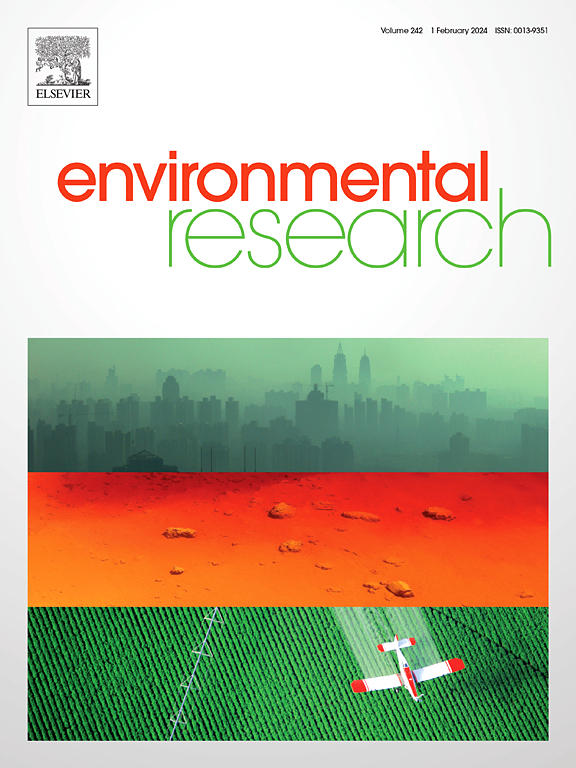A potential mechanism of triclosan-induced neurotoxicity in zebrafish at environmental Concentrations: Splicing disruption of tecra mediates the circRNA266/miR-214/dapk2-gad2 axis
IF 7.7
2区 环境科学与生态学
Q1 ENVIRONMENTAL SCIENCES
引用次数: 0
Abstract
Many environmental pollutants are known to exhibit neurotoxic effects; however, the initiating molecular events and their associated adverse outcome pathways (AOPs) remain largely unclear. This study investigated the role of circRNA266 and its target miRNA in Triclosan (TCS)-induced neurodevelopmental toxicity in zebrafish (Danio rerio) based on candidates circRNAs identified via high-throughput sequencing. Toxicological effects were characterized at multiple levels, including phenotype alterations, motor behavior, neural damage, and the expression of marker genes. TCS exposure was found to upregulate circRNA266, thereby reducing the availability of free miR-214. As a crucial neuroprotective factor, miR-214 downregulation was associated with increased expression of dapk2 and gad2, resulting in elevated inhibitory neurotransmitter levels and neuronal apoptosis. Furthermore, molecular docking analysis suggests that the upregulation of circRNA266 by TCS may occur via its interaction with U2AF1, thereby disrupting the splicing of the tecra gene. While high concentrations of TCS caused marked neurotoxic phenotypes and behavioral impairments, environmentally relevant concentrations did not elicit overt symptoms. Nonetheless, the activation of key molecular events within the AOP framework suggests a potential neurotoxic risk even at low exposure levels. This study is the first to confirm that TCS induces neurotoxicity in zebrafish by interfering with the splicing of the tecra gene and mediating the regulatory role of the circRNA266/miR-214/dapk2-gad2 signaling axis. These findings provide novel insights into the molecular mechanisms of TCS-induced neurotoxicity and propose a potential new AOP model for environmental risk assessment.
环境浓度下三氯生诱导斑马鱼神经毒性的潜在机制:tecra剪接破坏介导circRNA266/miR-214/dapk2-gad2轴
已知许多环境污染物具有神经毒性作用;然而,启动分子事件及其相关的不良后果途径(AOPs)仍不清楚。本研究基于高通量测序鉴定的候选环状rna,研究了circRNA266及其靶miRNA在三氯生(TCS)诱导的斑马鱼(Danio rerio)神经发育毒性中的作用。毒理学效应在多个水平上表现出来,包括表型改变、运动行为、神经损伤和标记基因的表达。发现TCS暴露可上调circRNA266,从而降低游离miR-214的可用性。作为重要的神经保护因子,miR-214下调与dapk2和gad2表达增加相关,导致抑制性神经递质水平升高和神经元凋亡。此外,分子对接分析表明,TCS上调circRNA266可能通过其与U2AF1的相互作用发生,从而破坏tecra基因的剪接。虽然高浓度的TCS会引起明显的神经毒性表型和行为障碍,但环境相关浓度不会引起明显的症状。尽管如此,AOP框架内关键分子事件的激活表明即使在低暴露水平下也存在潜在的神经毒性风险。本研究首次证实TCS通过干扰tecra基因剪接和介导circRNA266/miR-214/dapk2-gad2信号轴的调控作用诱导斑马鱼神经毒性。这些发现为tcs诱导神经毒性的分子机制提供了新的见解,并提出了一种潜在的新的AOP环境风险评估模型。
本文章由计算机程序翻译,如有差异,请以英文原文为准。
求助全文
约1分钟内获得全文
求助全文
来源期刊

Environmental Research
环境科学-公共卫生、环境卫生与职业卫生
CiteScore
12.60
自引率
8.40%
发文量
2480
审稿时长
4.7 months
期刊介绍:
The Environmental Research journal presents a broad range of interdisciplinary research, focused on addressing worldwide environmental concerns and featuring innovative findings. Our publication strives to explore relevant anthropogenic issues across various environmental sectors, showcasing practical applications in real-life settings.
 求助内容:
求助内容: 应助结果提醒方式:
应助结果提醒方式:


